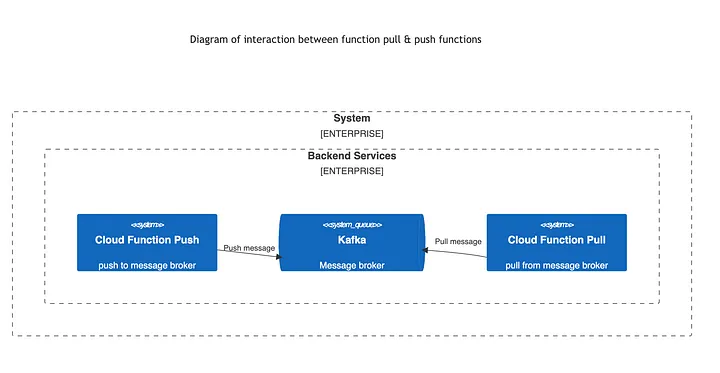Spring Cloud Functions, Kafka - How to interact asynchronous
Introduction
This article will show how to use the Spring Cloud Functions projects. The Spring Cloud Functions is the best approach to implementing a straightforward business logic. Nowadays, the usage of message brokers such as Kafka has increased. I will implement a simple system in this article, as shown below.

Implementation
I will start with a simple example of a cloud function, which is the same as a rest endpoint in the classical spring boot web application. You can create a project from your favorite IDE or from Spring Initliazr.
<?xml version="1.0" encoding="UTF-8"?>
<project xmlns="http://maven.apache.org/POM/4.0.0" xmlns:xsi="http://www.w3.org/2001/XMLSchema-instance"
xsi:schemaLocation="http://maven.apache.org/POM/4.0.0 https://maven.apache.org/xsd/maven-4.0.0.xsd">
<modelVersion>4.0.0</modelVersion>
<parent>
<groupId>org.springframework.boot</groupId>
<artifactId>spring-boot-starter-parent</artifactId>
<version>3.2.1</version>
<relativePath/> <!-- lookup parent from repository -->
</parent>
<groupId>io.vrnsky</groupId>
<artifactId>cloud-function-push</artifactId>
<version>0.0.1-SNAPSHOT</version>
<name>cloud-function-push</name>
<description>cloud-function-push</description>
<properties>
<java.version>17</java.version>
<spring-cloud.version>2023.0.0</spring-cloud.version>
</properties>
<dependencies>
<dependency>
<groupId>org.springframework.cloud</groupId>
<artifactId>spring-cloud-function-context</artifactId>
</dependency>
<dependency>
<groupId>org.springframework.cloud</groupId>
<artifactId>spring-cloud-starter-function-web</artifactId>
</dependency>
<dependency>
<groupId>org.springframework.boot</groupId>
<artifactId>spring-boot-starter-test</artifactId>
<scope>test</scope>
</dependency>
</dependencies>
<dependencyManagement>
<dependencies>
<dependency>
<groupId>org.springframework.cloud</groupId>
<artifactId>spring-cloud-dependencies</artifactId>
<version>${spring-cloud.version}</version>
<type>pom</type>
<scope>import</scope>
</dependency>
</dependencies>
</dependencyManagement>
<build>
<plugins>
<plugin>
<groupId>org.springframework.boot</groupId>
<artifactId>spring-boot-maven-plugin</artifactId>
</plugin>
</plugins>
</build>
</project>Your pom.xml file or build.gradle should like this.
The first step is to describe events related to service. I will stick with the following definition of an event
package io.vrnsky.cloudfunctionpush.domain;
import java.util.List;
public record PullRequestAccepted(
String author,
List<String> reviewers,
boolean havePassedAllChecks
) {
}The first step is to describe events related to service. I will stick with the following definition of an event. The second step is to create a configuration class within the bean function creation inside it.
package io.vrnsky.cloudfunctionpush.config;
import io.vrnsky.cloudfunctionpush.domain.PullRequestAccepted;
import org.springframework.context.annotation.Bean;
import org.springframework.context.annotation.Configuration;
import java.util.function.Function;
@Configuration
public class FunctionConfig {
@Bean
public Function<PullRequestAccepted, String> pullRequestAccepted() {
return value -> """
Pull request from %s has been reviewed by %s. Have passed all checks: %b
"""
.formatted(
value.author(),
value.reviewers().size(),
value.havePassedAllChecks()
);
}
}